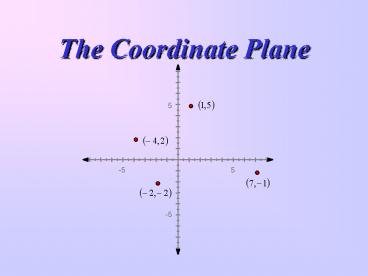The Coordinate Plane - PowerPoint PPT Presentation
Title:
The Coordinate Plane
Description:
One is horizontal, like the number line you already know. -5. 5. 0. 10 -10 ... Use your own words to explain what each term means: Origin. Quadrant. Axis. Coordinates ... – PowerPoint PPT presentation
Number of Views:127
Avg rating:3.0/5.0
Title: The Coordinate Plane
1
The Coordinate Plane
2
Imagine the top surface of your desk stretching
in every direction.
- If it continued to spread , it would go right
through your neighbor . . .
. . . and then through the classroom walls . . .
3
. . . and through the school and the hills and
the mountains and out into space until it went on
forever in every direction.
Then you would have a plane.
4
In mathematics, a plane is a flat surface that
goes on forever in every direction.
- In Algebra, we often use the coordinate plane.
5
The coordinate plane is divided by two number
lines. One is horizontal, like the number line
you already know.
6
The other is vertical, with up being the positive
direction and down being the negative direction.
7
(No Transcript)
8
The coordinate plane is filled with points . . .
9
. . . infinitely many points.
- And somewhere among all those points is the point
we call the origin.
10
The origin is the point where the two number
lines meet.
11
The two number lines have special names.
- The horizontal number line is called the x-axis.
- The vertical number line is called the y-axis.
12
The plural of axis is axes. We often talk about
the coordinate axes.
13
To study a point, we need to know where to find
it. So we give it coordinates.
- Coordinates are like an address. They tell you
how you can get to a point if you start at the
origin.
14
Coordinates are always written in parentheses,
with the x-value first.
15
Coordinates written in parentheses are called an
ordered pair.
16
Consider the point which has coordinates, (4, -2).
So the 4 in (4, -2) says we need to move 4 units
to the right.
- The first number tells you how far to move along
the x-axis.
Remember to start at the origin!
17
The second number tells you how far to move up or
down.
- The 2 in (4, -2) tells you to move down two
units.
18
To get to the origin from the origin, we dont
move at all.
- So the origin is designated by the ordered pair,
(0, 0)
19
In Quadrant II, x-values are negative, while
y-values are positive.
In Quadrant I, all values are positive.
The two number lines divide the plane into four
regions.
We call the regions quadrants.
Quadrants are labeled with Roman Numerals.
In Quadrant IV, x-values are positive and
y-values are negative.
In Quadrant III, x- and y-values are both
negative.
20
Give the coordinates of each point
21
Plot each point and describe how to get to the
point from the origin.
- From the origin, move to the right 8 units, then
down 7 units.
- (8,7)
- (4,0)
- (4,5)
- (0,9)
- (7,12)
From the origin, move to the right 4 units, then
stop (Stay on the x-axis.).
From the origin, move to the left 4 units, then
down 5 units.
From the origin, dont move to the right or left
(stay on the y-axis), then move down 9 units.
From the origin, move to the right 7 units, then
up 12 units.
22
Use your own words to explain what each term
means
- Origin
- Quadrant
- Axis
- Coordinates
- Ordered pair































